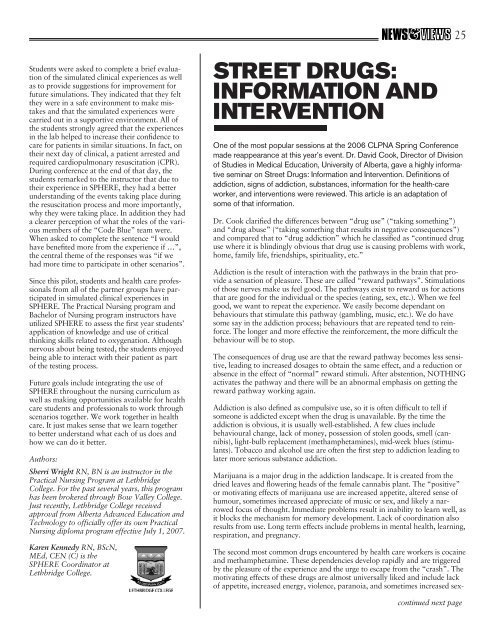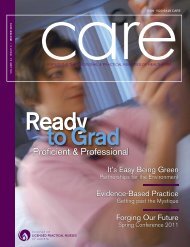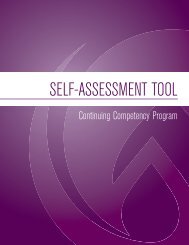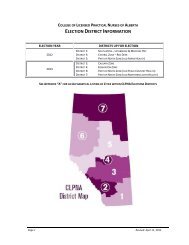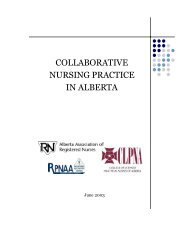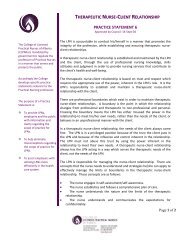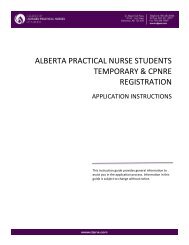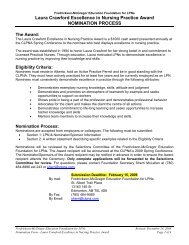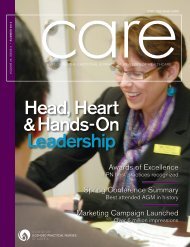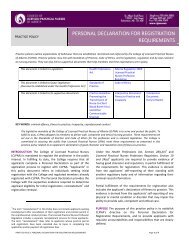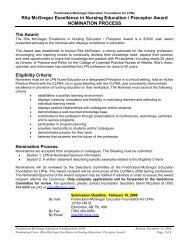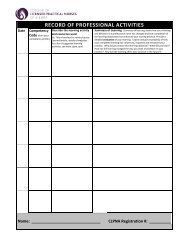Download PDF - College of Licensed Practical Nurses of Alberta
Download PDF - College of Licensed Practical Nurses of Alberta
Download PDF - College of Licensed Practical Nurses of Alberta
- No tags were found...
You also want an ePaper? Increase the reach of your titles
YUMPU automatically turns print PDFs into web optimized ePapers that Google loves.
25Students were asked to complete a brief evaluation<strong>of</strong> the simulated clinical experiences as wellas to provide suggestions for improvement forfuture simulations. They indicated that they feltthey were in a safe environment to make mistakesand that the simulated experiences werecarried out in a supportive environment. All <strong>of</strong>the students strongly agreed that the experiencesin the lab helped to increase their confidence tocare for patients in similar situations. In fact, ontheir next day <strong>of</strong> clinical, a patient arrested andrequired cardiopulmonary resuscitation (CPR).During conference at the end <strong>of</strong> that day, thestudents remarked to the instructor that due totheir experience in SPHERE, they had a betterunderstanding <strong>of</strong> the events taking place duringthe resuscitation process and more importantly,why they were taking place. In addition they hada clearer perception <strong>of</strong> what the roles <strong>of</strong> the variousmembers <strong>of</strong> the “Code Blue” team were.When asked to complete the sentence “I wouldhave benefited more from the experience if …”,the central theme <strong>of</strong> the responses was “if wehad more time to participate in other scenarios”.Since this pilot, students and health care pr<strong>of</strong>essionalsfrom all <strong>of</strong> the partner groups have participatedin simulated clinical experiences inSPHERE. The <strong>Practical</strong> Nursing program andBachelor <strong>of</strong> Nursing program instructors haveutilized SPHERE to assess the first year students’application <strong>of</strong> knowledge and use <strong>of</strong> criticalthinking skills related to oxygenation. Althoughnervous about being tested, the students enjoyedbeing able to interact with their patient as part<strong>of</strong> the testing process.Future goals include integrating the use <strong>of</strong>SPHERE throughout the nursing curriculum aswell as making opportunities available for healthcare students and pr<strong>of</strong>essionals to work throughscenarios together. We work together in healthcare. It just makes sense that we learn togetherto better understand what each <strong>of</strong> us does andhow we can do it better.Authors:Sherri Wright RN, BN is an instructor in the<strong>Practical</strong> Nursing Program at Lethbridge<strong>College</strong>. For the past several years, this programhas been brokered through Bow Valley <strong>College</strong>.Just recently, Lethbridge <strong>College</strong> receivedapproval from <strong>Alberta</strong> Advanced Education andTechnology to <strong>of</strong>ficially <strong>of</strong>fer its own <strong>Practical</strong>Nursing diploma program effective July 1, 2007.Karen Kennedy RN, BScN,MEd, CEN (C) is theSPHERE Coordinator atLethbridge <strong>College</strong>.STREET DRUGS:INFORMATION ANDINTERVENTIONOne <strong>of</strong> the most popular sessions at the 2006 CLPNA Spring Conferencemade reappearance at this year’s event. Dr. David Cook, Director <strong>of</strong> Division<strong>of</strong> Studies in Medical Education, University <strong>of</strong> <strong>Alberta</strong>, gave a highly informativeseminar on Street Drugs: Information and Intervention. Definitions <strong>of</strong>addiction, signs <strong>of</strong> addiction, substances, information for the health-careworker, and interventions were reviewed. This article is an adaptation <strong>of</strong>some <strong>of</strong> that information.Dr. Cook clarified the differences between “drug use” (“taking something”)and “drug abuse” (“taking something that results in negative consequences”)and compared that to “drug addiction” which he classified as “continued druguse where it is blindingly obvious that drug use is causing problems with work,home, family life, friendships, spirituality, etc.”Addiction is the result <strong>of</strong> interaction with the pathways in the brain that providea sensation <strong>of</strong> pleasure. These are called “reward pathways”. Stimulations<strong>of</strong> those nerves make us feel good. The pathways exist to reward us for actionsthat are good for the individual or the species (eating, sex, etc.). When we feelgood, we want to repeat the experience. We easily become dependant onbehaviours that stimulate this pathway (gambling, music, etc.). We do havesome say in the addiction process; behaviours that are repeated tend to reinforce.The longer and more effective the reinforcement, the more difficult thebehaviour will be to stop.The consequences <strong>of</strong> drug use are that the reward pathway becomes less sensitive,leading to increased dosages to obtain the same effect, and a reduction orabsence in the effect <strong>of</strong> “normal” reward stimuli. After abstention, NOTHINGactivates the pathway and there will be an abnormal emphasis on getting thereward pathway working again.Addiction is also defined as compulsive use, so it is <strong>of</strong>ten difficult to tell ifsomeone is addicted except when the drug is unavailable. By the time theaddiction is obvious, it is usually well-established. A few clues includebehavioural change, lack <strong>of</strong> money, possession <strong>of</strong> stolen goods, smell (cannibis),light-bulb replacement (methamphetamines), mid-week blues (stimulants).Tobacco and alcohol use are <strong>of</strong>ten the first step to addiction leading tolater more serious substance addiction.Marijuana is a major drug in the addiction landscape. It is created from thedried leaves and flowering heads <strong>of</strong> the female cannabis plant. The “positive”or motivating effects <strong>of</strong> marijuana use are increased appetite, altered sense <strong>of</strong>humour, sometimes increased appreciate <strong>of</strong> music or sex, and likely a narrowedfocus <strong>of</strong> thought. Immediate problems result in inability to learn well, asit blocks the mechanism for memory development. Lack <strong>of</strong> coordination alsoresults from use. Long term effects include problems in mental health, learning,respiration, and pregnancy.The second most common drugs encountered by health care workers is cocaineand methamphetamine. These dependencies develop rapidly and are triggeredby the pleasure <strong>of</strong> the experience and the urge to escape from the “crash”. Themotivating effects <strong>of</strong> these drugs are almost universally liked and include lack<strong>of</strong> appetite, increased energy, violence, paranoia, and sometimes increased sex-continued next page


